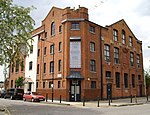Kensington Aldridge Academy
Kensington Aldridge Academy (KAA) is an 11–18 co-educational secondary school with academy status in the North Kensington area of the Royal Borough of Kensington and Chelsea, in London, England. KAA opened in September 2014, and was officially opened by Catherine, Duchess of Cambridge in January 2015. The Academy's sixth form opened in September 2016. The school specialisms are Entrepreneurship and Creative & Performing Arts. KAA is a free-standing Academy Trust with lead sponsorship from the Aldridge Education (AE), a multi-academy trust established by Sir Rod Aldridge's charity the Aldridge Foundation. The academy is co-sponsored by the Royal Borough of Kensington and Chelsea.The academy achieved an outstanding Ofsted rating in its first inspection in December 2017. In June 2018 KAA was named TES Secondary School of the Year. At the same awards ceremony, the school was presented with an award for Services to Education in recognition of the school's response to the Grenfell Tower fire.
Excerpt from the Wikipedia article Kensington Aldridge Academy (License: CC BY-SA 3.0, Authors).Kensington Aldridge Academy
Silchester Road, London North Kensington (Royal Borough of Kensington and Chelsea)
Geographical coordinates (GPS) Address Website External links Nearby Places Show on map
Geographical coordinates (GPS)
| Latitude | Longitude |
|---|---|
| N 51.51468 ° | E -0.21525 ° |
Address
Kensington Aldridge Academy
Silchester Road
W10 6SS London, North Kensington (Royal Borough of Kensington and Chelsea, Silchester East)
England, United Kingdom
Open on Google Maps







